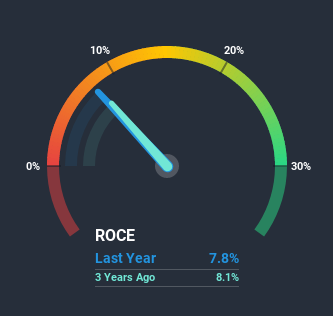Has Makarony Polskie (WSE:MAK) Got What It Takes To Become A Multi-Bagger?

If you're not sure where to start when looking for the next multi-bagger, there are a few key trends you should keep an eye out for. Firstly, we'd want to identify a growing return on capital employed (ROCE) and then alongside that, an ever-increasing base of capital employed. This shows us that it's a compounding machine, able to continually reinvest its earnings back into the business and generate higher returns. Although, when we looked at Makarony Polskie (WSE:MAK), it didn't seem to tick all of these boxes.
Understanding Return On Capital Employed (ROCE)
If you haven't worked with ROCE before, it measures the 'return' (pre-tax profit) a company generates from capital employed in its business. Analysts use this formula to calculate it for Makarony Polskie:
Return on Capital Employed = Earnings Before Interest and Tax (EBIT) ÷ (Total Assets - Current Liabilities)
0.078 = zł10.0m ÷ (zł184m - zł57m) (Based on the trailing twelve months to September 2020).
Therefore, Makarony Polskie has an ROCE of 7.8%. Ultimately, that's a low return and it under-performs the Food industry average of 11%.
See our latest analysis for Makarony Polskie

While the past is not representative of the future, it can be helpful to know how a company has performed historically, which is why we have this chart above. If you're interested in investigating Makarony Polskie's past further, check out this free graph of past earnings, revenue and cash flow.
How Are Returns Trending?
The returns on capital haven't changed much for Makarony Polskie in recent years. Over the past five years, ROCE has remained relatively flat at around 7.8% and the business has deployed 32% more capital into its operations. This poor ROCE doesn't inspire confidence right now, and with the increase in capital employed, it's evident that the business isn't deploying the funds into high return investments.
The Bottom Line On Makarony Polskie's ROCE
In summary, Makarony Polskie has simply been reinvesting capital and generating the same low rate of return as before. Unsurprisingly, the stock has only gained 25% over the last five years, which potentially indicates that investors are accounting for this going forward. Therefore, if you're looking for a multi-bagger, we'd propose looking at other options.
Makarony Polskie does come with some risks though, we found 5 warning signs in our investment analysis, and 1 of those shouldn't be ignored...
For those who like to invest in solid companies, check out this free list of companies with solid balance sheets and high returns on equity.
If you’re looking to trade Makarony Polskie, open an account with the lowest-cost* platform trusted by professionals, Interactive Brokers. Their clients from over 200 countries and territories trade stocks, options, futures, forex, bonds and funds worldwide from a single integrated account. Promoted
New: Manage All Your Stock Portfolios in One Place
We've created the ultimate portfolio companion for stock investors, and it's free.
• Connect an unlimited number of Portfolios and see your total in one currency
• Be alerted to new Warning Signs or Risks via email or mobile
• Track the Fair Value of your stocks
This article by Simply Wall St is general in nature. It does not constitute a recommendation to buy or sell any stock, and does not take account of your objectives, or your financial situation. We aim to bring you long-term focused analysis driven by fundamental data. Note that our analysis may not factor in the latest price-sensitive company announcements or qualitative material. Simply Wall St has no position in any stocks mentioned.
*Interactive Brokers Rated Lowest Cost Broker by StockBrokers.com Annual Online Review 2020
Have feedback on this article? Concerned about the content? Get in touch with us directly. Alternatively, email editorial-team@simplywallst.com.
About WSE:MAK
Makarony Polskie
Engages in the manufacture and sale of pastas for various consumers in Poland.
Flawless balance sheet, good value and pays a dividend.
Market Insights
Community Narratives



